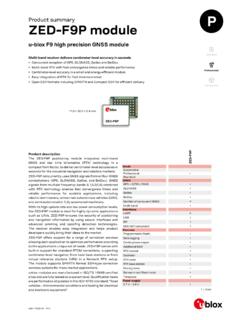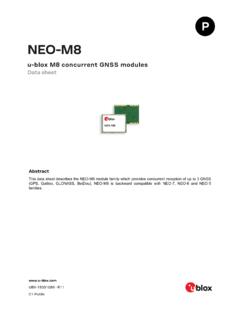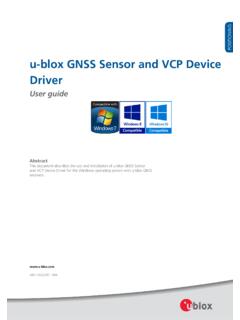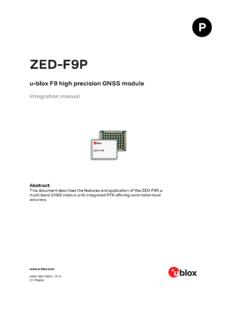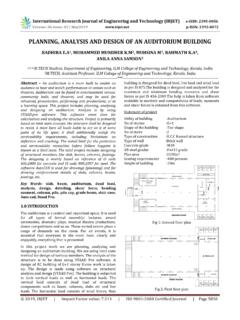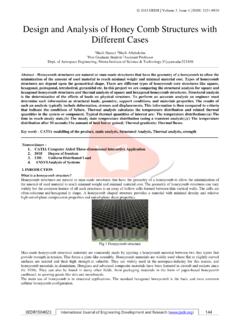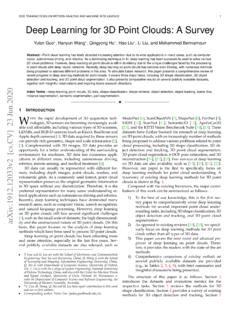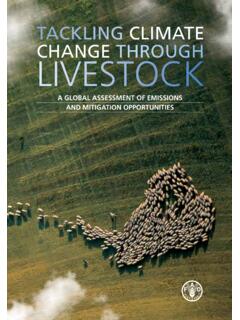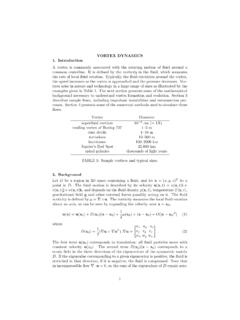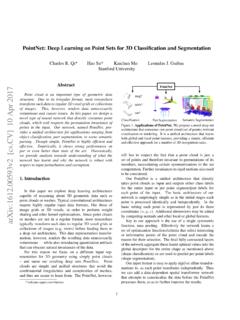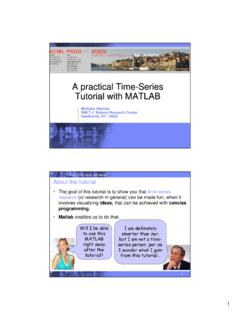Transcription of ZED-F9P - U-blox
1 UBX-19009093 - R02 C1-Public ZED-F9P Moving base applications Application note Abstract This application note explains how the ZED-F9P multi-band GNSS receiver can be employed in applications that require high precision relative position output or heading and attitude information. ZED-F9P - Application note UBX-19009093 - R02 Document information Page 2 of 23 C1-Public Document information Title ZED-F9P Subtitle Moving base applications Document type Application note Document number UBX-19009093 Revision and date R02 22-Jul-2020 Disclosure Restriction C1-Public This document applies to the following products: Product name Type number Firmware version Product status ZED-F9P ZED-F9P -02B-00 Early production information U-blox or third parties may hold intellectual property rights in the products, names, logos and designs included in this document.
2 Copying, reproduction, modification or disclosure to third parties of this document or any part thereof is only permitted with the express written permission of U-blox . The information contained herein is provided as is and U-blox assumes no liability for its use. No warranty, either express or implied, is given, including but not limited to, with respect to the accuracy, correctness, reliability and fitness for a particular purpose of the information. This document may be revised by U-blox at any time without notice. For the most recent documents, visit Copyright U-blox AG. ZED-F9P - Application note UBX-19009093 - R02 Contents Page 3 of 23 C1-Public Contents Document information .. 2 Contents .. 3 Introduction .. 4 Terminology and fundamentals .. 4 Real-world applications .. 5 System-level considerations.
3 8 GNSS antenna considerations for moving base RTK .. 8 Ground plane size and shape .. 8 Multipath/obscuration from surrounding structures .. 9 Providing corrections between base and rover ..10 Wired connection between base and rover ..11 Wireless connection between base and rover ..12 Testing and debugging an RF link application ..13 Improving RF link performance ..14 Receiver configurations ..15 Default 1 Hz navigation rate application ..15 8 Hz navigation rate application ..16 Using the heading output ..18 Using the C099-F9P as a moving base application .. 19 Wired UART base and rover ..20 Appendix .. 21 A Glossary .. 21 Related documents .. 22 Revision history .. 22 Contact .. 23 ZED-F9P - Application note UBX-19009093 - R02 Introduction Page 4 of 23 C1-Public Introduction The ZED-F9P multi-band GNSS receiver [1] has integrated U-blox multiband RTK technology for centimeter-level accuracy.
4 This application note explains how ZED-F9P can be employed in applications that require high precision relative position output or heading and attitude information. This is enabled by the so-called moving base support in the module firmware. This first section introduces the basic terminology and essential elements of a moving base setup with two or more GNSS receivers and shows some typical application scenarios. Section 2, which makes up the core of this application note, covers in-depth system-level considerations from antenna placement up to module configuration. Finally, we present how a moving base application can be easily set up with the help of the C099-F9P application board. Terminology and fundamentals RTK technology introduces the concept of a base and a rover.
5 In such a setup, the base sends a continuous differential correction data stream (complying with the RTCM protocol) to one or more rovers via a communication link. This enables the rover to compute its position relative to the base with high accuracy. The vector (or relative position) between base and rover is called the baseline. In the standard RTK mode, the base remains static in a known position, while in the moving base (MB) RTK mode, both base and rover receivers can move. The latter is ideal for applications where the relative position offset between two moving vehicles is required such as, for example, the follow-me feature on a UAV. The moving base feature also enables derivation of the vehicle orientation by mounting two or three GNSS receivers on the same vehicle platform, that is, by fixing the position of the GNSS antennas relative to each other.
6 Figure 1: Orientation of a vehicle in space Mounting two antennas on the X-axis gives heading and roll information. With three antennas you can derive full attitude; heading, roll and pitch. The heading information and relative position is output by the rover. See section on the output from ZED-F9P . Using differential correction data for the base receiver If the absolute position of the rover is required with high precision, the base unit can be provided with correction data as well. See Figure 2 for such a setup. This will allow the base to enter RTK Fixed mode ZED-F9P - Application note UBX-19009093 - R02 Introduction Page 5 of 23 C1-Public with the resultant improvement of absolute position accuracy. Without receiving corrections, the base will have standard 3D Fix position accuracy.
7 Figure 2: Moving base setup for precise heading and precise absolute position of the rover In Figure 2, the rear antenna is the base antenna, front antenna is the rover antenna. Heading is from the base to the rover antenna. Real-world applications Moving base support can be used in a wide area of applications, for example: Drone attitude and heading determination Drone follow me sport and filming applications Ship heading determination Ship portable pilot units Vehicle heading determination Heavy machinery motion control Farming vehicle heading determination and control Traditional survey with moving base addition Sports data analysis Cellular base station antenna alignment Figure 3: Drone attitude determination base and rover on drone ZED-F9P - Application note UBX-19009093 - R02 Introduction Page 6 of 23 C1-Public Figure 4: Farming application position and heading, base and rover on vehicle Figure 5: Drone follow me filming only a rover on the drone typically Figure 6.
8 Heavy machinery control blade leveling and heading, base and rover on vehicle ZED-F9P - Application note UBX-19009093 - R02 Introduction Page 7 of 23 C1-Public Figure 7: Automotive vehicle heading determination base and rover on vehicle Figure 8: Antenna pointing systems base and rover on single-cell antenna panel Figure 9: Portable ship pilot systems for entering/exiting harbors - base and rover on ship Table 1 describes typical parameters of the above mentioned applications. Application Key data Number of GNSS receivers Baseline length and type Drone attitude and heading determination Roll, pitch and yaw 3 Fixed baseline, 20-30 cm Drone follow me sport and filming applications Heading, relative position 2 Several meters Precise ship navigation Heading 2 Fixed baseline, up to 100 m Automotive vehicle heading determination Heading 2 Fixed baseline, 1-3 m Antenna attitude measurement and control Heading / attitude 2 Fixed baseline, 10-50 cm Table 1.
9 Typical moving base applications and key characteristics ZED-F9P - Application note UBX-19009093 - R02 System-level considerations Page 8 of 23 C1-Public System-level considerations As outlined in the previous section, two or more GNSS receivers (with separate antennas) are required to determine the relative position between the GNSS receivers. We will now provide recommendations and detailed examples on how to develop high-performance moving base applications with U-blox ZED-F9P receivers. GNSS antenna considerations for moving base RTK The following points only need to be considered if a patch antenna is used and the application has a short baseline and minimal space for ground planes. Typically, these points need to be considered for heading determination in drones and cellular antenna pointing.
10 The use of a helix antenna would be ideal for such applications as they do not require ground planes. Long baselines (meters to kilometers) are not affected. If used on the same vehicle for heading and precise attitude determination (a drone for example), the antennas should be identical and ideally on an identical ground plane size and shape. In addition the antennas should be orientated in the same plane. Figure 10: Very short baseline, heading application patch antenna mounting Ground plane size and shape In an application where the base and rover are far removed from each other, such as where the rover is on a drone and the base is on a ship, the ground plane shape will have much less effect as the baseline is very long kilometers possibly.



